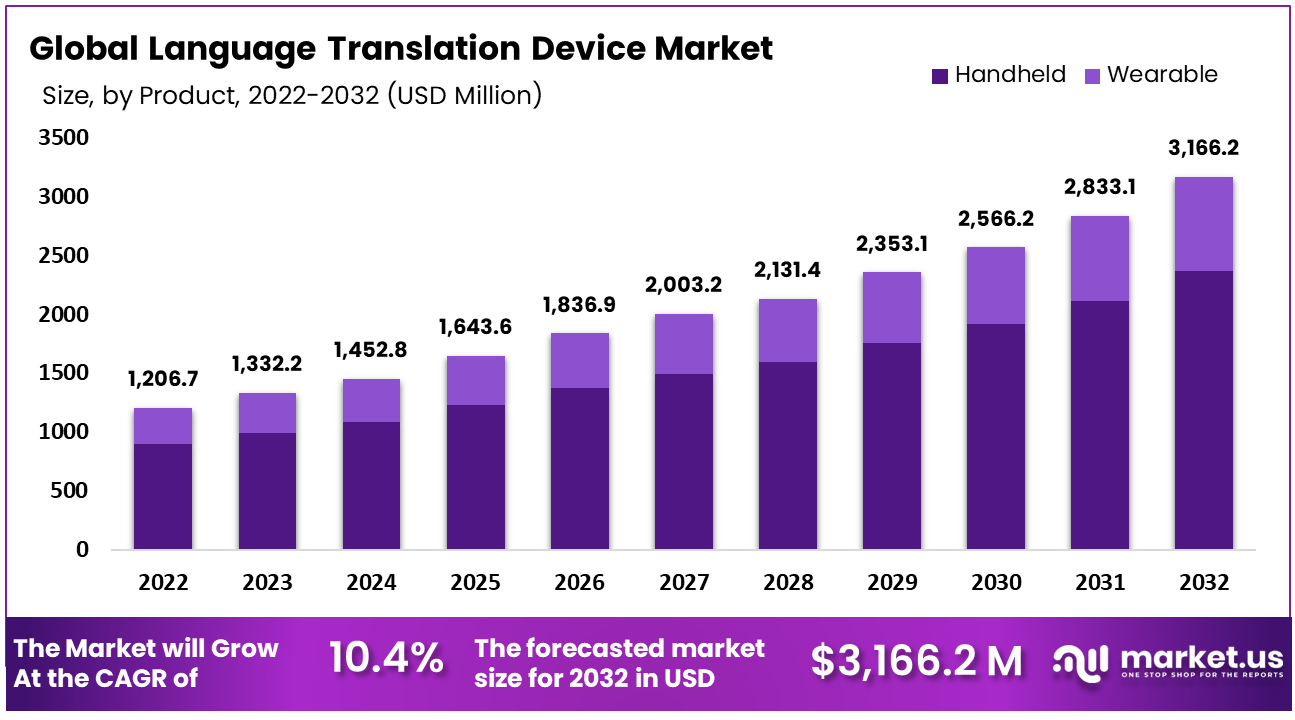Language Translation Device Market Projected To Reach a Revised Size Of USD 3,166.2 Mn By 2032

Page Contents
Published Via 11Press : The Language Translation Device Market refers to an industry involved with producing, designing, and selling devices that facilitate real-time language translation in real time between languages. Such devices aim at breaking language barriers with accurate instantaneous translations between these various dialects.
Language translation devices come in all sorts of forms – handhelds, earbuds, mobile apps, and smart speakers are among them – typically using technologies such as speech recognition, natural language processing, machine learning, and cloud-based databases for translations. Some require internet connectivity while others may feature built-in translation databases allowing offline use.
The Language Translation Device Market Size Was To Reach USD 1,206.7 Mn In 2022 And is Projected To Reach a Revised Size Of USD 3,166.2 Mn By 2032, Growing At A CAGR of 10.4%
Language translation devices have experienced exponential growth since 2010, driven by globalization, travel and tourism increases, and the need to communicate seamlessly in multicultural settings. Language translators have become popular with travelers, business professionals, healthcare providers, and individuals hoping to break language barriers across various scenarios.
Request For Sample Report Here: https://market.us/report/language-translation-device-market/#requestSample

Key Takeaways
- The market is expected to grow at a CAGR of over 10.4 % from 2023 to 2030.
- The growth of the market is being driven by the increasing demand for language translation devices in the travel and tourism industry, the business sector, and the education sector.
- The development of sophisticated solutions powered by data-based AI and machine learning is emerging as a major trend accelerating industry dynamics.
- The online translation segment is expected to acquire nearly 60% of the language-translation device market revenue share in 2022.
- The Asia Pacific region is expected to be the fastest-growing market for language translation devices during the forecast period.
Regional Analysis
- North America:
North America, particularly the United States, has a significant presence in the language translation devices market. The region is technologically advanced and has a high demand for language translation solutions due to its multicultural population and global business interactions. The market is driven by the increasing need for seamless communication across different languages in various sectors, including healthcare, tourism, and retail. - Europe:
Europe is another prominent region in the language translation devices market. Countries like Germany, France, and the United Kingdom have a strong presence of language translation device manufacturers and service providers. The European Union's multilingual environment, coupled with cross-border business collaborations, drives the demand for translation devices. Additionally, the region's emphasis on tourism also contributes to the growth of the market. - Asia Pacific:
The Asia Pacific region is witnessing rapid growth in the language translation devices market. Countries such as China, Japan, South Korea, and India are major contributors to this growth. The increasing globalization of businesses, rising tourism, and growing international trade are driving the demand for language translation devices in the region. - Latin America:
Latin America is an emerging market for language translation devices. Countries like Brazil, Mexico, and Argentina are witnessing increased adoption of translation devices, driven by the growth of international tourism, cross-border business activities, and the need for effective communication in multilingual settings. - Middle East and Africa:
The Middle East and Africa region are also experiencing growth in the language translation devices market. The region's diverse population, which includes expatriate workers, tourists, and international students, drives the demand for translation solutions. Moreover, the growing e-commerce sector and the need for language translation in business interactions contribute to the market growth in this region.
Drivers
- Globalization and International Business: The increasing globalization of businesses and international trade has amplified the need for effective communication across language barriers. Language translation devices enable seamless communication and facilitate smoother business interactions, leading to enhanced collaboration and efficiency in global markets.
- Multicultural Societies: Many regions and countries have diverse populations with multiple languages spoken. Language translation devices cater to the needs of multicultural societies, helping individuals overcome language barriers in various settings such as healthcare, education, hospitality, and public services.
- Travel and Tourism: The travel and tourism industry relies heavily on language translation devices to provide a better experience for international travelers. These devices enable tourists to communicate with locals, navigate unfamiliar locations, and access information in their native language, contributing to a more enjoyable and comfortable travel experience.
- Language Learning and Education: Language translation devices play a significant role in language learning and education. They facilitate language acquisition by providing real-time translations, pronunciation assistance, and vocabulary support. Language learners, students, and educators utilize these devices to improve language skills and promote effective communication.
Restraints
- Accuracy and Quality: Language translation devices rely on machine learning algorithms and artificial intelligence to deliver translations, with significant progress made towards reaching perfect accuracy and quality translations; yet reaching this goal remains difficult, due to translating complex sentences, idioms or context-specific phrases accurately proving difficult for machine translation systems, leading to potential errors and inaccuracies that compromise accuracy and quality in translations.
- Language Complexity: There is an enormous diversity in languages spoken worldwide, each boasting their own set of specific complexities and subtleties. Some include complex grammatical structures, dialects or regional variations which pose particular difficulties when translated through translation devices.
- Cultural and Contextual Understanding: Effective translation requires not just translating words between languages but also understanding cultural and contextual nuances associated with those two languages. While translation devices may provide some assistance here, their abilities often fall short when trying to grasp cultural connotations, humor or idiomatic expressions deeply ingrained within one specific tongue.
- Connectivity and Accessibility: For effective language translation devices to function effectively in areas with limited or unreliable internet connectivity, they require accessing cloud-based translation services or databases via internet connections. When this connection fails completely or in parts where internet service may be intermittent or intermittently unreliable, their effectiveness could be severely limited.
Opportunities
- Increased Globalization: Globalization has increased the importance of effective communication across languages and cultures. As businesses expand globally and more people travel frequently, language translation devices become an invaluable asset to assist with seamless international cooperation across borders by breaking down language barriers for seamless dialogues between nations and peoples.
- Tourism Industry Growth: Tourism industry expansion continues at an astounding rate with more people traveling internationally for leisure or business purposes, creating more market demand for language translation devices such as translation software.
- Multilingual Workplaces: Many companies operate within diverse linguistic environments where employees speak various languages. Language translation devices can assist employees in effectively communicating and collaborating within these multilingual workplaces without extensive language proficiency requirements, increasing productivity while encouraging inclusivity.
- Language Learning and Education: Translation devices can serve as invaluable aids for both language learners and educators, offering real-time translation assistance, pronunciation guidance, language practice opportunities and supplementing traditional methods of study by helping language students practice more quickly while immersing themselves deeper in a particular language.
Top Key Players
- Lionbridge Technologies, Inc.
- Bigword Group Ltd.
- LanguageLine Solutions
- Google Inc.
- IBM Corporation
- Global Linguist Solutions
- Sourcenext Inc. (Pocketalk)
- Jarvisen (iFLYTEK)
- Cheetah Mobile, Inc.
- Vasco Electronics LLC
- Waverly Labs Inc.
- Other Key Players.
Market Segmentation
By Product
- Handheld
- Wearable
By Type
- Online Translation
- Offline Translation
By Application
- Consumer
- Commercial
By Distribution Channel
- E-commerce
- Retail Stores
Make an Inquiry Before Picking Up This Report @ https://market.us/report/language-translation-device-market/#inquiry
Challenges
- Globalization-Driven Communications Needs: Globalization has increased the need for effective cross-cultural communications between various languages and cultures, prompting businesses to expand internationally while people travel more regularly; language translation devices offer convenient portable solutions that facilitate seamless dialogue across borders as a result of this increase.
- Tourism Industry Growth: Tourism industry expansion continues unabated. People travel more regularly for both leisure and business reasons across various countries; more people need language translation devices to enhance the travel experience by communicating with locals, navigating unfamiliar environments, and understanding local customs and traditions.
- Multilingual Workplaces: Many companies operate within multilingual environments where employees speak various languages. Translating devices are indispensable in maintaining effective communication and collaboration among these multilingual environments; enabling employees to understand each other without needing extensive language proficiency.
- Language Learning and Education: Language translation devices can serve as invaluable resources for language students and educators, offering real-time translation assistance, pronunciation guidance, language practice opportunities, and supplementing traditional methods of study more easily.
Recent Development
- Advances in Neural Machine Translation (NMT): Neural Machine Translation has made significant strides toward increasing accuracy and quality in translations, thanks to deep learning algorithms powered NMT models which excel at capturing context better and producing more natural-sounding translations.
- Integrating Artificial Intelligence (AI) and Machine Learning (ML): Language translation devices have increasingly employed AI and ML technologies to boost translation capabilities and ensure continuous improvements over time in translation accuracy. These techniques enable devices to learn over time while steadily honing translation accuracy over time.
- Portable and Wearable Translation Devices: Recent developments have focused on developing more portable and wearable translation devices. From smart earbuds and handheld devices to portable translation capabilities.
- Integration With Smart Devices and Internet of Things (IoT): Language translation devices have begun integrating into smart home devices, vehicles, and IoT ecosystems for user control of translation features using voice commands or connected applications. This development gives people access to these features more conveniently.
Report Scope
| Report Attribute | Details |
| The market size value in 2023 | USD 1,206.7 Mn |
| Revenue Forecast by 2032 | USD 3,166.2 Mn |
| Global Market Growth Rate (2023 to 2032) | CAGR Of 10.4 % |
| Regions Covered | North America, Europe, Asia Pacific, Latin America, and Middle East & Africa, and Rest of the World |
| Historical Years | 2017-2022 |
| Base Year | 2022 |
| Estimated Year | 2023 |
| Short-Term Projection Year | 2028 |
| Long-Term Projected Year | 2032 |
FAQs
Q1: What are language translation devices?
A1: Language translation devices are portable electronic devices or applications that can translate spoken or written words from one language to another in real-time.
Q2: How do language translation devices work?
A2: Language translation devices typically use technologies such as machine learning, natural language processing, and artificial intelligence to analyze and process input speech or text, identify the language, and generate translations in the desired language.
Q3: What are the benefits of language translation devices?
A3: Language translation devices enable effective communication across language barriers, facilitating interactions in diverse settings such as travel, business, education, healthcare, and more. They enhance convenience, save time, and promote cross-cultural understanding.
Q4: What are the challenges of language translation devices?
A4: Challenges include maintaining high accuracy in complex translations, handling dialects and accents, providing real-time translation, addressing privacy concerns, and ensuring affordable pricing. Connectivity limitations and competition from mobile apps and online tools also present challenges.
Contact
Global Business Development Team – Market.us
Market.us (Powered by Prudour Pvt. Ltd.)
Send Email: [email protected]
Address: 420 Lexington Avenue, Suite 300 New York City, NY 10170, United States
Tel: +1 718 618 4351
Website: https://market.us/
Content has been published via 11press. for more details please contact at [email protected]
The team behind market.us, marketresearch.biz, market.biz and more. Our purpose is to keep our customers ahead of the game with regard to the markets. They may fluctuate up or down, but we will help you to stay ahead of the curve in these market fluctuations. Our consistent growth and ability to deliver in-depth analyses and market insight has engaged genuine market players. They have faith in us to offer the data and information they require to make balanced and decisive marketing decisions.



